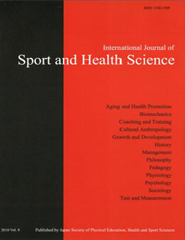Volume 3
Displaying 1-15 of 15 articles from this issue
- |<
- <
- 1
- >
- >|
Aging and Health Promotion
-
Article type: Paper
Subject area: Aging and Health Promotion
2005 Volume 3 Pages 83-90
Published: 2005
Released on J-STAGE: January 23, 2008
Download PDF (314K)
Biomechanics
-
Article type: Brief Paper
Subject area: Biomechanics
2005 Volume 3 Pages 110-115
Published: 2005
Released on J-STAGE: January 23, 2008
Download PDF (385K) -
Article type: Paper
Subject area: Biomechanics
2005 Volume 3 Pages 35-45
Published: 2005
Released on J-STAGE: January 23, 2008
Download PDF (1851K) -
Article type: Paper
Subject area: Biomechanics
2005 Volume 3 Pages 75-82
Published: 2005
Released on J-STAGE: January 23, 2008
Download PDF (563K) -
Article type: Paper
Subject area: Biomechanics
2005 Volume 3 Pages 100-109
Published: 2005
Released on J-STAGE: January 23, 2008
Download PDF (735K) -
Article type: Paper
Subject area: Biomechanics
2005 Volume 3 Pages 116-128
Published: 2005
Released on J-STAGE: January 23, 2008
Download PDF (882K)
Coaching and Training
-
Article type: Paper
Subject area: Coaching and Training
2005 Volume 3 Pages 21-26
Published: 2005
Released on J-STAGE: January 23, 2008
Download PDF (498K)
Cultural Anthropology
-
Article type: Paper
Subject area: Cultural Anthropology
2005 Volume 3 Pages 27-34
Published: 2005
Released on J-STAGE: January 23, 2008
Download PDF (259K)
Epidemiology
-
Article type: Development Paper
Subject area: Epidemiology
2005 Volume 3 Pages 57-67
Published: 2005
Released on J-STAGE: January 23, 2008
Download PDF (730K)
Growth and Development
-
Article type: Paper
Subject area: Growth and Development
2005 Volume 3 Pages 129-141
Published: 2005
Released on J-STAGE: January 23, 2008
Download PDF (494K)
Pedagogy
-
Article type: Materials
Subject area: Pedagogy
2005 Volume 3 Pages 10-20
Published: 2005
Released on J-STAGE: January 23, 2008
Download PDF (739K) -
Article type: Paper
Subject area: Pedagogy
2005 Volume 3 Pages 46-56
Published: 2005
Released on J-STAGE: January 23, 2008
Download PDF (485K)
Physiology
-
Article type: Paper
Subject area: Physiology
2005 Volume 3 Pages 68-74
Published: 2005
Released on J-STAGE: January 23, 2008
Download PDF (514K) -
Article type: Paper
Subject area: Physiology
2005 Volume 3 Pages 91-99
Published: 2005
Released on J-STAGE: January 23, 2008
Download PDF (357K)
Psychology
-
Article type: Materials
Subject area: Psychology
2005 Volume 3 Pages 1-9
Published: 2005
Released on J-STAGE: January 23, 2008
Download PDF (349K)
- |<
- <
- 1
- >
- >|
